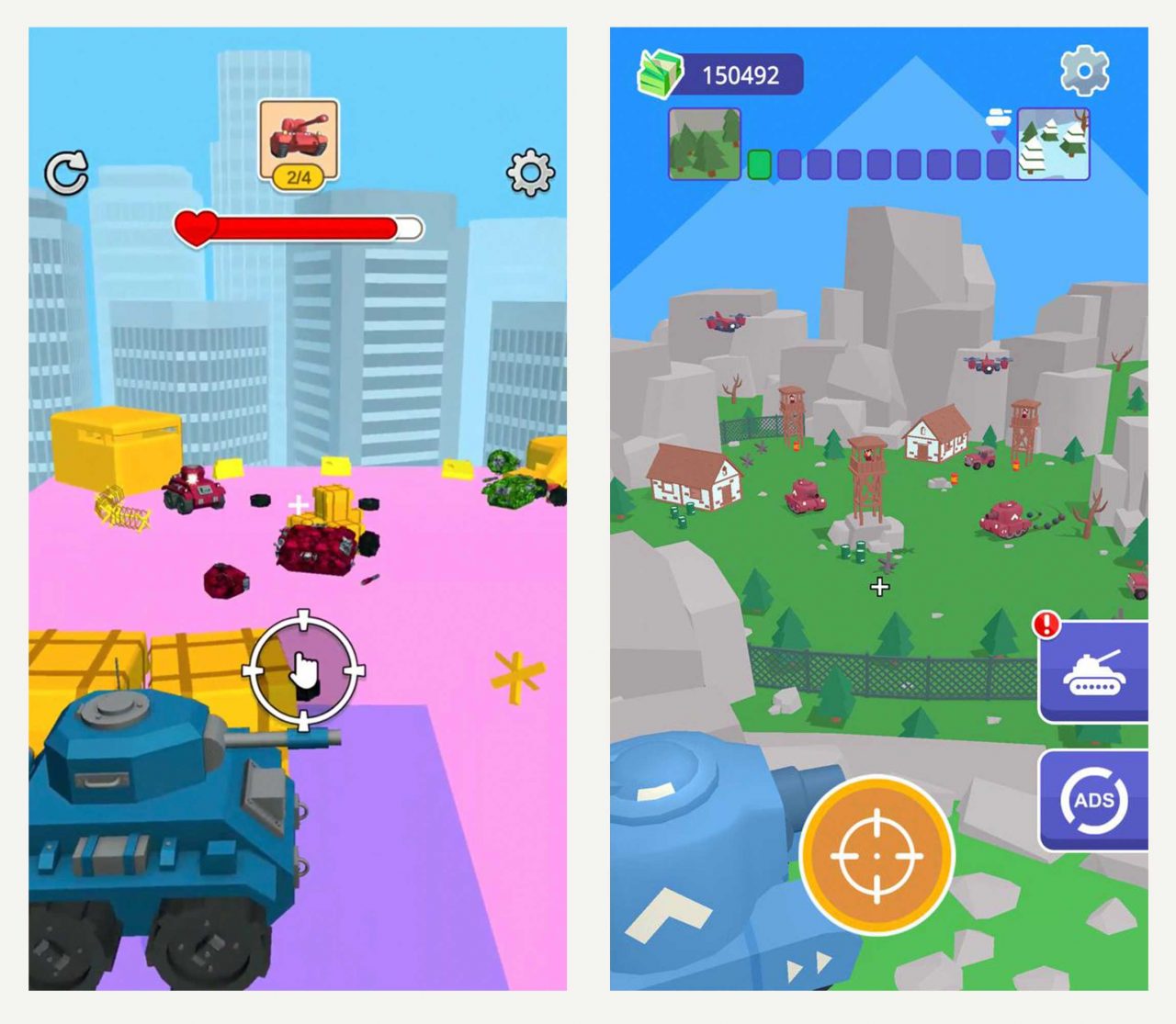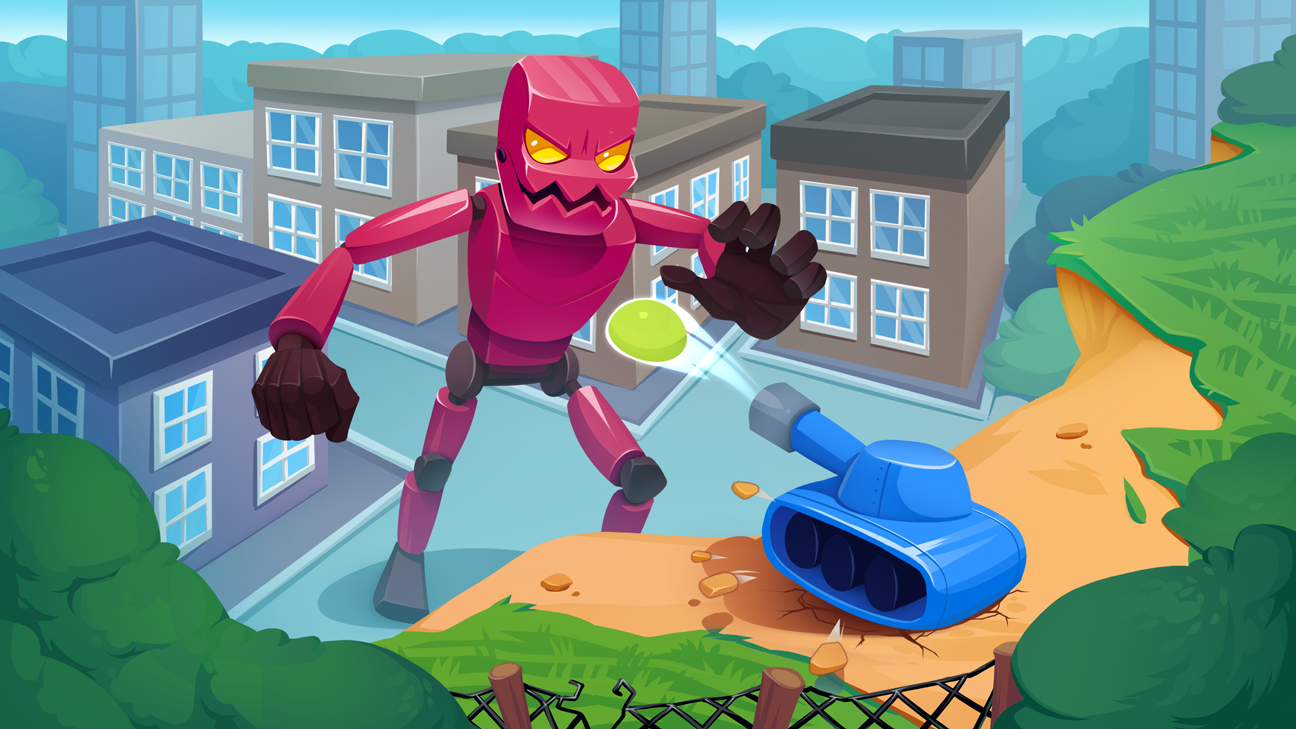From an indie developer to a full-cycle studio with the publisher. Part 3. Tank Sniper
After Western Sniper was released, we were developing Mafia Sniper and decided to take on another project in the same genre. It was supposed to become an exhibit of all our accumulated experience and bring something new to the genre. The idea came from within the studio — by that time the Bazinga team had increased and was ready for experiments.
“The idea was to find a new audience, move away from the characters from the first two games and switch to vehicles. It was just a hypothesis, and the first metrics at the prototype stage came out conflicting, so the project was put on ice for some time while we were actively developing Mafia Sniper. But after that, we went right back to tanks,” — Adrian Garciuc, CEO of Bazinga.
The beginning
We finished the prototype quite quickly, but it didn’t hit the mark in terms of the visuals — the graphics were too “heavy” for hyper-casual. On first tests, this resulted in a high CPI (60-70 cents), although R1 of about 33% is enough to determine that the game has good potential and to keep iterating. We were 100% sure that we could raise the first day retention to over 40% and bring down the CPI. Spoiler alert: that’s exactly what happened.
First, we made the visuals more casual. Initially, it was closer to midcore, with complex texturing and geometry, which probably was a turn-off for the hyper-casual audience. We smoothed out the textures, reworked and “lightened” all the assets. Plus, we made the opponents and important elements of the environment the focal points. We removed the half-shadows to make the picture “cleaner”, but left simple shadows for volume and ordered cartoon shaders. All this immediately triggered growth in all respects.

Secondly, we focused on entertaining gameplay and destructible environments. Playing the game started to feel completely different — it became very lively, deeper than typical hyper-casual projects.
We started making almost all assets and environments unique. With the first two projects, the main work on models happened inside Azur Games and was just being shared with the developers after the fact, but by the time Tank Sniper was being developed, Bazinga had already hired its own 3D artists and had good expertise on the subject. We still help them with sketches, skeletons, animation, and sound, but they do the main work themselves, since they’re a full-cycle studio now.
The game has inherited the engine and some effects from previous projects, but this time it’s not about the hard meta: the focus has shifted to interesting, unusual, and destructible levels, unique bosses, and enemy behavior that didn’t quite fit the standards of hyper-casual.
“We quickly realized that we weren’t going to find the game’s unique play style just by replacing characters with vehicles. It was slow and not engaging at all. After we tested destructible environments, the game started to shine in a completely new way. We decided to focus on the entertainment factor in all aspects. For example, explosions on the ground and in the air are made differently. All this is accompanied by sound design, the objects raise clouds of dust when they fall, etc.,” — Alexander Nikanshin, game designer at Bazinga.
Development process and game design
“The engine is from the first two projects, but the game itself had to actually be made from scratch. Even things like aiming that are invisible to the players were adapted to vehicles,” — Alexander Nikanshin, game designer at Bazinga.
The new setting also opened up more room for experiments. We tried to make a complex system of enemy parameters and played different armor, damage, and speed stats. In addition, reinforcements were coming in, there were a lot of opponents, and the player couldn’t figure out how many shots they needed to destroy one unit. As a result, users left because of the low win rate. That’s when it was decided to move towards entertainment, not hardcore gameplay. We reduced the number of opponents, made an analogue of a headshot (hitting a tank turret), and so on. After that, the game became closer to hyper-casual in terms of gameplay, just as we marketed it.
We’ve spent the biggest chunk of time on optimization to make mobile devices process a large number of collapsing objects in the frame. We had to find a balance between visual quality and performance. The first iteration with destructibles made the game freeze due to the large number of physical objects and complex geometry. We had to manually optimize the polygonal mesh for each piece, as well as experiment with the number of buildings in one scene.
Another distinctive feature of the new project is the flexibility in terms of adding new content. It’s much more flexible than Western Sniper or Mafia Sniper, which were limited to Wild West or mid-20th century American settings. In Tank Sniper, the only enemies were tanks at first, but they were slow and too easy to play against. To add some challenge, we implemented off-road vehicles that quickly move around the map. After that, we found that in a landscape mode all units are on the ground and the space above the horizon is not occupied by anything. Then we added drones (small fast units) and two types of helicopters (light and assault). Moreover, the light helicopter has two types of weapons, so its attacks change depending on which side it turns towards the player. If the helicopter is shot down, it doesn’t just explode, but falls and causes destruction to the environment. In addition to being visually appealing, this adds a challenge to players who need to time their shots more accurately.
We also added some sci-fi elements in the form of huge robot bosses. They differ not just in terms of armor, but have a certain behavior pattern, similar to classic video game bosses — they move around the level, go behind buildings, and perform dangerous attacks with a certain timing. When they’re destroyed, the bosses fall apart according to the same principle as environmental objects.
We did full sound design, greatly raising its quality compared to previous projects. It adds to the entertainment value, just like the visuals, physics and assets.
In the end, it was the focus on the entertainment aspect that made the game unique and recognizable. Even though the project is at the very beginning of its journey and is still far from peaking, the metrics are already speaking for themselves:
- R1 — 40+%.
- R7 — 7,7+%.
Now we’re actively working on a new meta. There were different types of weapons in Mafia Sniper, but in Tank Sniper you can attach different effects, perks, ranks, medals to each tank — the upgrade process will become much more interesting. In the future, we also plan to add vehicles, new levels, including naval-themed stuff. We have a ton of theories, but they still need to be tested.
Changes in the team
Tank Snipers is only gaining momentum, but the studio has already grown a lot. The team got a chance to learn how convenient having your own assets and graphics is, hired 3D artists and made a pack of unique in-game objects tailored specifically to their needs. Now it’s their internal know-how, we’re just offering feedback and help in certain issues. Bazinga has become a full-cycle development studio on its own initiative, which is very cool.
“The growing expertise and quality from project to project leads to a paradox that doesn’t make it easier to work. Tank Sniper is much more difficult than our previous games, especially in technical terms. Everything has evolved — the tasks, visuals, our approach to marketing — as a result, you have to take on more and more complex things and learn new tricks. This makes the studio grow and puts the products on a new level,” — Alexander Nikanshin, game designer at Bazinga.
“We started a company as two people, and now there are about a dozen specialists involved in all the processes, including several outsourced workers. We developed many skills inside the studio while working on the latest projects in the sniper genre. We greatly increased our productivity, raised the quality of level design, and learned many technical things that we hadn’t encountered before. We’re always ready to expand the team, if necessary. In the meantime, we’re handling everything fine and growing organically. There was a situation in the past where we had four developers, one level designer and one technical artist — that setup was very heavy and unbalanced. It doesn’t make much sense to heap the engineers with tasks when they don’t have normal assets, animations, and so on. We try not to repeat such mistakes and focus on projects that already make something or have good potential,” — Adrian Garciuc, Bazinga CEO.
The studio also continues to work on Western Sniper — which is in its revival phase — by conducting new tests and preparing updates. We’re also gradually improving Mafia Sniper, but Tank Sniper is our priority.
At the same time, we’re making and testing several more prototypes with Bazinga. The studio and us at Azur Games have a huge library of assets and environments combined. Based on it (and the expertise that the studio has built up), we already envision our future joint projects. There won’t be prototypes in the usual sense, they will start as full-fledged games right away. Many studios dream of releasing projects of this quality, but for us it will be just a build of the mechanics and features that we’ve already thought out, worked out and made.
“While working on the third game with Azur Games, we focused on quality. This is what the publisher suggested we do from the very beginning and what we saw for ourselves. Unique assets, destructibility, sounds, effects, controls, general look & feel of the gameplay — now we’re working on all of it much deeper than is customary in hyper-casual games. With the current state of the hyper-casual market, the projects that focus on some kind of unique mechanics, but are haphazard from the execution standpoint, have a very small chance of becoming successful. The bar has been raised so much in terms of quality that making ten projects in a month and waiting for one of them to become a hit has stopped being a winning tactic,” — Adrian Garciuc, Bazinga CEO.
